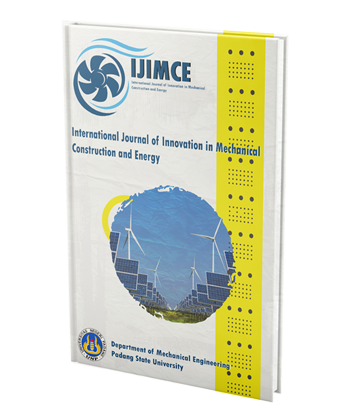Taro Crushing Machine Design Using Aluminum Knife Disc
Keywords:
Taro, crushing machine, design, aluminum knifeAbstract
There are many agricultural communities, one of which is taro, because the season is suitable for the territory of Indonesia. With the development of appropriate technological advances, technological tools that can process agricultural products can be found, so thinking about how to improve and ease work or process crops or process taro products to increase the selling price even better. The purpose of the research in general is to make it easier to slice taro for chip entrepreneurs, especially taro chips, and can also be operated for cutting or slicing such as tempeh, potatoes, sweet potatoes, carrots, etc. The specific purpose for making this tool is to know the capacity of the taro chopper, to know the components in the taro chopper and to analyze the results of the taro chopper cut. From the manufacture of the tool, it can be concluded that this taro chopper is operated semi-automatically using an electric motor. This machine display method is a single display with 1 type of blade that cuts the taro continuously. The design of this taro chopper machine requires power from an electric motor of 0.54 HP with a rotation of 2800 rpm. The production capacity of the taro machine every 60 minutes is able to stretch as much as 1536 kg.
Downloads
References
S. Koswara, “Teknologi pengolahan umbi-umbian,” Bogor Res. Community Serv. Inst. IPB, 2013.
Wardianto, D., Hafni, H., & Perkasa, M. H. Pembuatan Dan Pengujian Mesin Perajang Talas. Jurnal
Teknologi dan Vokasi, 1(1), 31-37. 2023
Andi, R. A., Arif, G., & Cici, A. RANCANG BANGUN MESIN PERAJANG DAUN TALAS
BENENG (Doctoral dissertation, Politeknik Manufaktur Negeri Bangka Belitung), 2021.
Mulyaningsih, N., & Choirul, C. Upaya Peningkatan Produksi Keripik Talas Melalui Penerapan
Mesin Perajang Di Desa Balesari. Jurnal ABDINUS: Jurnal Pengabdian Nusantara, 4(2), 329-338.
Husman, H., & Ariyono, S. Rancang Bangun Mesin Pengiris Singkong. Manutech: Jurnal Teknologi
Manufaktur, 10(02), 31-34. 2018.
Sularso and Kiyokatsu Suga. Dsar Planning and Selection of Engine Elements. PT. Pradnya Paramita,
Khurmi, R. S., & Gupta, J. K. (2005). A Textbook of Machine Design. In Eurasia Publishing House.
Eurasia Publishing House
M. Foley, “Design Guide on Pulleys and Belt Drives,” CMTco Engineering, 2022.
Engineering Toolbox, “Belt Transmission – Power and Speed,” The Engineering ToolBox, 2024.
[Online]. Available: https://www.engineeringtoolbox.com
W. D. Callister, Materials Science and Engineering: An Introduction, 7th ed., John Wiley & Sons, 2007.
Downloads
Published
How to Cite
Issue
Section
License
Copyright (c) 2025 Sir Anderson, Khairul Amri, Hanif, Nasirwan, Aina Edi Putri, Padli Raisman Akbari

This work is licensed under a Creative Commons Attribution-ShareAlike 4.0 International License.




